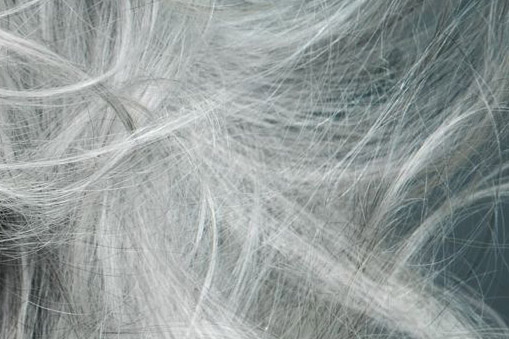While standing in the queue, a lady came from behind me and asked how old I was. Curious I replied, "Why do you want to know?" and, as the words came out of my mouth, the penny dropped. This sweet lady, who worked there, was asking because she was tasked with directing older folks (like over 60) ahead of the queue! With a laugh, I professed to being 45 but with a lot of grey hair.
Of course, seeing me from behind and then wearing a mask, she wouldn't have been able to see my not-60 face.
Typically, Europeans start to go grey in their 30s by which time most women (and men) should see some grey hairs. By the time they reach 50, they should have at least 50% grey. When you go grey is genetically determined so there is nothing that you can do about it.
I got the grey genes from my dad's side of the family and started going grey in my early 20s. At 21, I saw a few grey hairs. By 28, I had a fair amount - so much so that I dyed my hair for a few years. As I have a pet-hate for showing roots and my hair grows fast, I surrendered to Mother Nature in my mid-30s and made peace that grey was my new hair colour. Sure, I had liked my golden-brown, original natural colour, but not being tied to a dye bottle was worth the trade-off. I was liberated and freed. This is something that I hear often from other women who stop colouring their hair.
There is a lot more grey out there than is generally realised because hair dying has been the primary course of action, especially for women. It was only much older women - those over 70 perhaps - who were ever seen with grey-white hair. This probably explains why grey hair has had the connotation of being an affliction of the elderly. In reality, women in their 40s without grey hair would be unusual, not the norm, in a dye-free world. As my friend Tracey so rightly says, "And I'm surprised that 18 months into the pandemic anyone still thinks that silver/grey/platinum is purely age-related".
Fortunately, grey hair in women is a lot more trendy and, dare I say 'acceptable' - now than it was even a few years ago. Young models grace the catwalk sporting dyed grey locks, celebs are going grey and, more importantly, our friends and women around us are going grey. Having more grey-haired women around is confidence-building for those trying to transition. Critical mass is required.
Best of all, many women actually look better with their grey hair than too-dark dyed hair. The lighter shades of grey brighten the face. Also, a whole new palette of clothing colours opens up to you, especially cool tones (green-blue-grey) as well as vibrant hues like reds and berry colours. Sapphire, pinks, denium, black and metallics also work.
I am not adverse to hair colouring. There are a number of hair-colouring Instagram pages that have me transfixed. Skills, design, colours and incredible work. Not that I do it myself, but hair colouing can be fun and playful and all the colours of the rainbow, not just something to hide the grey.
COVID lockdown went a long way to liberating women from the dye cycle - and they are grateful for it. Being able to work from home, while undergoing the transition to grey, without the pressure of conforming to appearance expectations in the workplace, has been the blessing.
Like the browns, blondes, and reds, the greys, platinums, whites and silvers are hair colours and they're making a bold appearance.

No comments:
Post a Comment